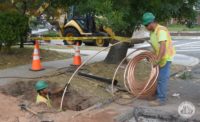The $15 billion designated for lead service line replacements in the Senate-passed bipartisan infrastructure bill is woefully short of what is needed to address the problem, say several industry officials familiar with drinking water issues. The White House initially proposed $45 billion for lead line replacements but Senate negotiators, concerned about the bill’s swelling price tag, trimmed that amount to $15 billion.
The package, which passed the Senate on Aug. 10, now moves to the House, where it faces significant hurdles. Some progressive Democrats have called for a more expansive bill, while more moderate Democrats have challenged the bill’s heft.
Meanwhile, some groups—ranging from labor unions to environmental advocates—are disappointed the Senate bill did not provide more funding for lead pipe replacements.
Tommy Holmes, legislative director for the American Water Works Association, says the amount in the Senate bill is a “down payment” for a much larger undertaking. “I’ve said all along that we are grateful for any additional funding that Congress can provide to address lead service lines," he says. "Everybody just needs to understand what the actual price tag will be.”
Most current estimates say it would take upward of $60 billion to replace from 6 million to 10 million lead service lines estimated in systems across the country.
Amrou Atassi, a vice president and senior project manager at CDM Smith, who is helping the city of Chicago with a lead service line replacement program, says, “Almost every community and city I have talked to that is serious about lead service line replacement is very eager to find out what is going to happen.”
Atassi says other funding mechanisms exist. The US Environmental Protection Agency’s Water Infrastructure Finance and Innovation Act, the US Dept, of Housing and Urban Development’s Community Development Block Grants and the federal Water Infrastructure Improvements for the Nation Act all include funds for lead service line replacements, to varying degrees. But much of the funding is in the form of loans, not grants.
Some water utilities are putting lead replacement plans on hold until they find out what the final numbers in the infrastructure package will be, Atassi says.
The money in the current bill would likely be allocated through state drinking water revolving loan fund programs with some level of loan forgiveness.
On Aug. 11, the Senate narrowly approved the separate reconciliation measure’s first stage—a $3.5-trillion budget resolution that sets overall funding targets for each committee. Next will come detailed legislation fleshing out the budget framework.
House Speaker Nancy Pelosi (D-Calif.) says she would like to pass the budget resolution when lawmakers return from their recess on Aug. 23, and she is working with the Rules Committee to be able to advance both bills together.






Post a comment to this article
Report Abusive Comment